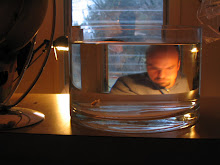Saturday, May 31, 2014
Exercise
As you open the car door, near the playground, she's all ears: she can hear the shrieks of children, and she leans far forward in her car seat and twists, in order to get the lay of the land. When she's out of the car, though, she can grow shy, and she'll often announce a familiar goal - 'Can you swing me in the big swing?' - partly in order to alleviate any uncertainty. That swing also gives her a perch, from which to watch the other kids, to gauge the temperature of the place. And so, after about ten minutes on the swing, she's often ready for something else - as today, when she had her eye on the spiral slide. So, too, though, did another little girl. At first, the two seemed impediments to each other: Cleo awkwardly chose to climb up the slide, as the other girl tentatively slid down. Within a few minutes, though, there had been a change: it was as if the kindling had caught fire, or the magnets had rotated, or...
...well, it was rather like watching, or listening to, one of the exercises described by Bruce Adolphe in The Mind's Ear: Exercises for Improving the Musical Imagination for Performers, Composers, and Listeners: "The flute continues to play this note," he writes, "and is joined by the trumpet. Hear them sounding together; hear the flute louder than the trumpet; hear the trumpet louder than the flute."
One girl goes up; one goes down. The two sit at the top of the slide together. The two slide down, at different paces, and say something to each other. And then, just as organically, the other little girl makes her way over to another slide, and Cleo saunters over to my bench, and says that it's time to go home.
"Now," writes Adolphe, "they both fade to silence." The exercise concludes.
Subscribe to:
Post Comments (Atom)





No comments:
Post a Comment